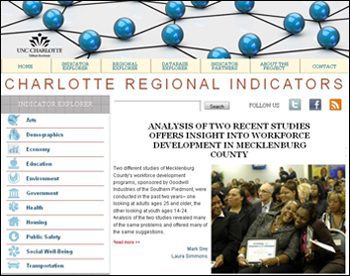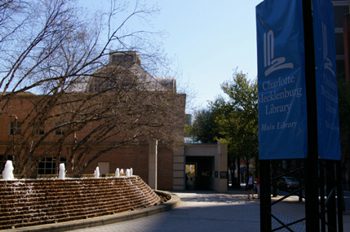Looking back, looking forward

This has been a year of change and growth for the UNC Charlotte Urban Institute. As I look back on the year’s highlights – and look forward to a new project we’ll debut early in 2012 – I’m reminded of the role the institute has played since 1969 in the greater Charlotte region. For those 40-plus years, as we’ve watched the region grow into a metropolitan area of 2 million people, our public service mission has not changed: We help communities find solutions to the social, economic and environmental challenges they face.
As part of that role, in fall 2010 we launched our newly designed website and online journal – http://ui.charlotte.edu – where we showcase research, analysis and commentary from institute researchers, the larger university and experts around our region and state. Here’s a sampling of our best-read articles for the year:
• “Charlotte region joblessness: the big, and painful, picture,” John Chesser’s August analysis of joblessness in the region over recent months (with an assist from graduate student Carlton Gideon).
• “Census 2010: Mecklenburg patterns of residential segregation,” in March, also by Chesser, part of a series of analyses by institute research staff of new U.S. Census data.
• “Why Charlotte went bananas for Chiquita,” associate director Mary Newsom’s Dec. 1 analysis of the courtship of Cincinnati-based Chiquita, later reprinted in the Charlotte Observer.
• “Find true independence with streetcars, not freeways,” one of several provocative commentaries from UNC Charlotte urban design professor David Walters.
 On June 30 we debuted our new, related website, the Charlotte Regional Indicators Project, a community resource that showcases statistical information from around the region. It’s a “dashboard” gauge, if you will, of how the region is doing, organized around 11 quality-of-life theme areas the institute tracks. It lets readers find up-to-date, research-quality data on topics from the arts to unemployment, and compare how this region is faring over time, and compared with benchmark cities across the United States.
On June 30 we debuted our new, related website, the Charlotte Regional Indicators Project, a community resource that showcases statistical information from around the region. It’s a “dashboard” gauge, if you will, of how the region is doing, organized around 11 quality-of-life theme areas the institute tracks. It lets readers find up-to-date, research-quality data on topics from the arts to unemployment, and compare how this region is faring over time, and compared with benchmark cities across the United States.
An exciting offshoot of the Indicators Project is our new Regional Indicators Partners program. We’ve joined with seven local agencies and governments to help them track data relevant to their own missions. The partners use the institute’s staff and data to tailor research to their specific needs. We’ve launched partner pages for the Council for Children’s Rights, the Urban League of Central Carolinas and the United Way of Central Carolinas. Coming in 2012 are portal pages for Goodwill Industries of the Southern Piedmont, Mecklenburg Citizens for Public Education, the Charlotte-Mecklenburg Women’s Summit and Gaston Together.
Also coming, early in 2012, will be the launch of a new project: PlanCharlotte.org.
With help from a grant from the Z. Smith Reynolds Foundation, the institute in June hired respected Charlotte Observer associate editor Mary Newsom to direct the new site, which will provide information, news and analysis about land use, the environment and growth-related issues throughout the region. Click here for a sneak preview and sign up to be notified when the site launches.
In the meantime, Mary’s long-running blog, newly renamed The Naked City Blog, has joined the institute’s website, ui.charlotte.edu. Look for the link in the lower right part of the web page.
Throughout 2011, the institute’s analyses have helped the community tackle some of its most important and, at times, most challenging issues.
• In February, the institute released its report for the Future of the Library Task Force. The institute’s study compared governmental revenue and library funding among Charlotte-Mecklenburg and 13 peer communities.
• The United Way of Central Carolinas asked the institute for a comprehensive assessment to pinpoint the community’s greatest needs and identify gaps in the array of human services. The final report, the United Way of Central Carolinas Community Needs Assessment, released in June 2011, offers wide-ranging recommendations such as focusing on prevention, supporting programmatic education and to change its funding model.
• The institute worked with Charlotte-Mecklenburg Schools to offer an online survey to the public, seeking input into what the public values as the school board searches for a new superintendent.
•The Charlotte Business Confidence Index is a collaborative effort among the City of Charlotte, the Charlotte Chamber, Advantage Carolina and the Charlotte-Mecklenburg Workforce Development Board. The institute conducts the research and analysis for this look ahead at expectations for the upcoming business quarter. In this period of economic uncertainty, the index has become a much-discussed barometer of future economic activity.
 We’re proud, too, of the roles of the institute and the whole university in a $5 million regional planning grant to the Centralina and the Catawba Regional councils of governments from the U.S. Department of Housing and Urban Development. The money will create a plan for sustainable development out of a series of community conversations held since 2007. The institute’s role will be to provide the metrics to be used in assessing the region’s progress toward a set of sustainability goals.
We’re proud, too, of the roles of the institute and the whole university in a $5 million regional planning grant to the Centralina and the Catawba Regional councils of governments from the U.S. Department of Housing and Urban Development. The money will create a plan for sustainable development out of a series of community conversations held since 2007. The institute’s role will be to provide the metrics to be used in assessing the region’s progress toward a set of sustainability goals.
The institute continues to serve communities outside of Mecklenburg, and one of its 2011 projects was a study for the Gaston County Schools that recommended closing three schools – always a difficult decision for any community. We were heartened to read these words in a Dec. 11 editorial in the Gaston Gazette: “… when it comes to the realities of funding and budgeting, emotions can cloud sound decision-making. An agency such as the Urban Institute can help bring clarity.”
We hope that in 2012 you will continue to join us regularly on this and our other two websites as we continue the institute’s rich tradition of working toward community understanding of the issues that shape who we are. We’re proud of the work we do to bring the clarity of impartial analysis to help decision makers and the public, as they work to build and improve communities throughout the Piedmont region of the Carolinas.
